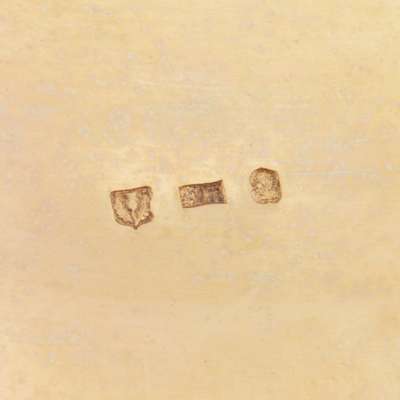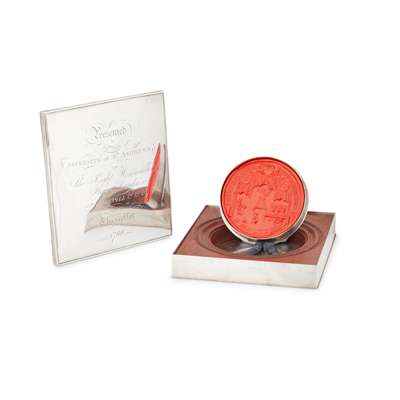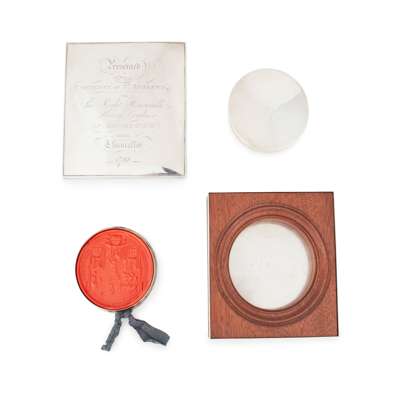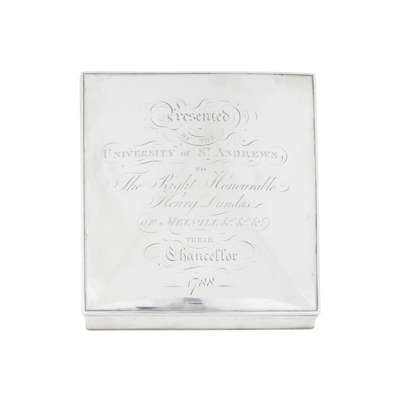
Lot 486

A GEORGE III ST. ANDREWS UNIVERSITY RECTORY BOX CONTAINING SEAL
PATRICK ROBERTSON, EDINBURGH 1788












Scottish Works of Art & Whisky
Auction: Lots 413 - 580 | 21 August 2024 at 10am
Description
the outer silver box of rectangular outline, engraved to the lid, ‘PRESENTED BY THE UNIVERSITY OF ST. ANDREW’S, TO The Right Honourable Henry Dundas OF MELVILLE &c &c &c THEIR CHANCELLOR 1788', fitted with a wooden lining containing a red wax seal and ribbon for the arms of St Andrews University, in a circular silver box
Dimensions
14.3 x 15.2 x 2.5cm: box dimensions, 9.2cm: diameter of seal box 12.4oz box, 24.4oz (gross weight)
Provenance
The Noble Collection
Purchased from J H Bourdon-Smith Ltd, January 2004
A Private East Coast Scottish Collection, collected over two generations
Footnote
Henry Dundas, 1st Viscount Melville, (1742 –1811), was born on the Royal Mile in 1742 and originally educated at Dalkeith Grammar School. A case of smallpox interrupted his education and after his convalescence, he restarted his instruction at Edinburgh's Royal High School. He studied Law at Edinburgh University and would hold positions as Solicitor General and Lord Advocate of Scotland before becoming the MP for Midlothian in 1744.
He was a close ally of Prime Minister William Pitt and served in various roles including that of War Secretary. He was a hugely powerful figure in Scottish politics and society at a time when Royal connections with Scotland were at their most removed, and he virtually ran the country on his own accord in the absence of Royal oversight. A controversial figure, he has now become most famous for delaying the abolition of slavery. In 1806 abolitionist Charles James Fox described Dundas as the man “who took a lead in constantly opposing our attempts at a total and immediate abolition” even though he knew the trade “to be adverse to policy, humanity, and justice.” It has been argued, however, that without his continued opposition and delaying, that abolition would never have been passed and it was due to a gradual transition deployed to work around Dundas’s objections that slavery was ended.
Ultimately, he was a great supporter of the Enlightenment and a figure well-known in Edinburgh. He was instrumental in the development and improvements around New Town, which brought many benefits to those who were then moved out of the slum conditions in Old Town at the time. Dundas is immortalised atop the 150-foot column standing centrally in St. Andrews Square today.
As he was appointed Chancellor of the University, it is quite apt that his statue is placed in St. Andrews Square. The oldest of the four ancient universities of Scotland, founded in 1413, St. Andrews University is still regarded as one of the foremost educational institutions in the world.
There are often manuscripts and correspondence from Melville that appear at auction and within the collection of National Museums Scotland, but it is scarce to find silver relating to Dundas. On the 17th of August 2016, Lyon & Turnbull sold The Henry Dundas Canongate Freedom Box, lot 364 for £1,900.











